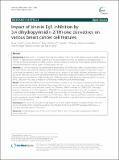Impact of kinesin Eg5 inhibition by 3,4-dihydropyrimidin-2(1H)-one derivatives on various breast cancer cell features
Author(s)
Guido, Bruna C; Ramos, Luciana M; Nobrega, Catharine C; Pic-Taylor, Aline; Neto, Brenno AD; Nolasco, Diego; Correa, Jose R; Andrade, Barbara YG; ... Show more Show less
Download12885_2015_Article_1274.pdf (2.691Mb)
OPEN_ACCESS_POLICY
Open Access Policy
Creative Commons Attribution-Noncommercial-Share Alike
Metadata
Show full item recordAbstract
Background
Breast cancer is a complex heterogeneous disease and is one of the leading causes of death among women. In addressing the need for treatments of this life-threatening illness, we studied 3,4-dihydropyrimidin-2(1H)-one (or thione) derivatives (DHPMs), a class of inhibitor molecules of the Eg5 motor spindle protein that shows pronounced antitumor activity against several cancer cell lines.
Methods
An in vitro screening was performed for identification of DHPMs with potent antitumor effects on MCF-7 and MDA-MB-231 cells and the selected DHPMs were evaluated for their inhibitory activity on Eg5 both in silico, using Molecular dynamics, and in vitro Eg5 inhibition assays. Analysis of cell death induction, proliferation, cell cycle and cancer stem cells (CSC) profile were performed by flow cytometry to assess the influence of the selected DPHMs on these important tumor features. Finally, the effects of DHPM treatment on tube formation were evaluated in vitro using HUVEC cells, and in vivo using a model on chorioallantoic membrane (CAM) of fertilized eggs.
Results
We identified five DHPMs with pronounced inhibitory activity on Eg5 motor protein interfering with the proper mitotic spindle assembly during cell division. These compounds impair the correct conclusion of cell cycle of the breast cancer cells and showed to be selective for tumor cells. Moreover, DHPMs modulate the CD44[superscript +]/CD24[superscript −] phenotype leading to a decrease in the CSC population in MDA-MB-231 cells, an important effect since CSC are resistant to many conventional cancer therapies and play a pivotal role in tumor initiation and maintenance. This observation was confirmed by the results which demonstrated that DHPM treated cells had impaired proliferation and were unable to sustain angiogenesis events. Finally, the DHMP treated cells were induced to apoptosis, which is one of the most pursued goals in drug development.
Conclusions
The results of our study strongly suggest that DHPMs inhibit important tumorigenic features of breast cancer cells leading them to death by apoptosis. These findings firmly point to DHPM molecular architecture as a promising alternative against breast cancer.
Date issued
2015-04Department
Massachusetts Institute of Technology. Research Laboratory of ElectronicsJournal
BMC Cancer
Publisher
BioMed Central
Citation
Guido, Bruna C, Luciana M Ramos, Diego O Nolasco, Catharine C Nobrega, Barbara YG Andrade, Aline Pic-Taylor, Brenno AD Neto, and Jose R Correa. “Impact of Kinesin Eg5 Inhibition by 3,4-Dihydropyrimidin-2(1H)-One Derivatives on Various Breast Cancer Cell Features.” BMC Cancer 15, no. 1 (December 2015).
Version: Final published version
ISSN
1471-2407